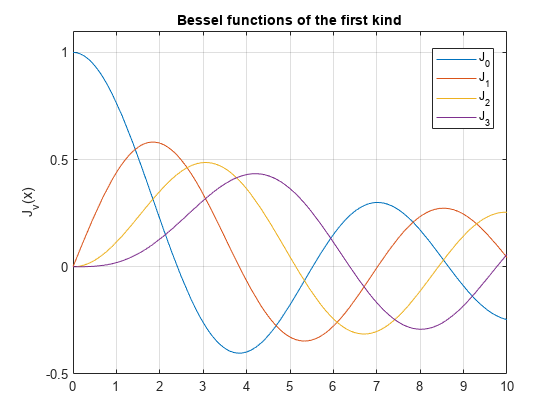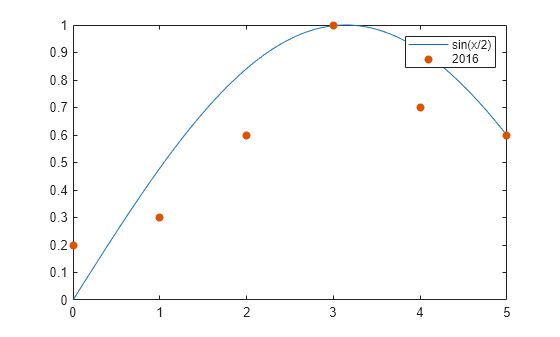Fplot Legend
- Plot Legend Of Tarzan Movie
- Plot Legends Of The Fall
- Plot Legends Of The Fall
- Fplot Legend
- Plot Legend In R
Gaussian Process Regression Models
Gaussian process regression (GPR) models are nonparametric kernel-basedprobabilistic models. You can train a GPR model using the fitrgp function.
Consider the training set ,where and ,drawn from an unknown distribution. A GPR model addresses the questionof predicting the value of a response variable ,given the new input vector ,and the training data. A linear regression model is of the form
Legends are a useful way to label data series plotted on a graph. These examples show how to create a legend and make some common modifications, such as changing the location, setting the font size, and adding a title. You also can create a legend with multiple columns or create a legend for a subset of the plotted data. Fplot(fun, limits). fplot is used to plot a function between specified limits. fun is a function handle to the function to be plotted. limits is a vector specifying the x-axis limits (xmin,xmax) or the x and y axes limits (xmin,xmax,ymin,ymax). fplot is an alternative to plot where, instead of having to generate the x and y coordinates first and passing them as arguments to. Legend places a legend on various types of graphs (line plots, bar graphs, pie charts, etc.). For each line plotted, the legend shows a sample of the line type, marker symbol, and color beside the text label you specify. When plotting filled areas (patch or surface objects), the legend contains a sample of the face color next to the text label. A list specifying aesthetic parameters of legend key. See details and examples. Nrow: The desired number of rows of legends. Ncol: The desired number of column of legends. If FALSE (the default) the legend-matrix is filled by columns, otherwise the legend-matrix is filled by rows. Reverse: logical. If TRUE the order of legends.
where .The error variance σ2 andthe coefficients β are estimated from thedata. A GPR model explains the response by introducing latent variables, ,from a Gaussian process (GP), and explicit basis functions, h.The covariance function of the latent variables captures the smoothnessof the response and basis functions project the inputs intoa p-dimensional feature space.
A GP is a set of random variables, such that any finite numberof them have a joint Gaussian distribution. If isa GP, then given n observations ,the joint distribution of the random variables isGaussian. A GP is defined by its mean function andcovariance function, .That is, if isa Gaussian process, then and
Now consider the following model.
where ,that is f(x) are from a zeromean GP with covariance function, . h(x)are a set of basis functions that transform the original feature vector x inRd into a new featurevector h(x) in Rp. β isa p-by-1 vector of basis function coefficients.This model represents a GPR model. An instance of response y canbe modeled as
Hence, a GPR model is a probabilistic model. There is a latentvariable f(xi)introduced for each observation ,which makes the GPR model nonparametric. In vector form, this modelis equivalent to
where
The joint distribution of latent variables inthe GPR model is as follows:
close to a linear regressionmodel, where looksas follows:
The covariance function is usually parameterized by a set of kernel parameters or hyperparameters, .Often iswritten as toexplicitly indicate the dependence on .
fitrgp estimates the basisfunction coefficients, ,the noise variance, ,and the hyperparameters,,of the kernel function from the data while training the GPR model.You can specify the basis function, the kernel (covariance) function,and the initial values for the parameters.
Because a GPR model is probabilistic, it is possible to compute the prediction intervals using the trained model (see predict and resubPredict).
You can also compute the regression error using the trained GPR model (see loss and resubLoss).
Compare Prediction Intervals of GPR Models
This example fits GPR models to a noise-free data set and a noisy data set. The example compares the predicted responses and prediction intervals of the two fitted GPR models.
Generate two observation data sets from the function .
The values in y_observed1 are noise free, and the values in y_observed2 include some random noise.
Fit GPR models to the observed data sets.
Compute the predicted responses and 95% prediction intervals using the fitted models.
Resize a figure to display two plots in one figure.
Create a 1-by-2 tiled chart layout.
For each tile, draw a scatter plot of observed data points and a function plot of . Then add a plot of GP predicted responses and a patch of prediction intervals.
When the observations are noise free, the predicted responses of the GPR fit cross the observations. The standard deviation of the predicted response is almost zero. Therefore, the prediction intervals are very narrow. When observations include noise, the predicted responses do not cross the observations, and the prediction intervals become wide.
References
[1] Rasmussen, C. E. and C. K. I. Williams. GaussianProcesses for Machine Learning. MIT Press. Cambridge,Massachusetts, 2006.
See Also
fitrgp predict RegressionGP
Related Topics
Sep 19 2017 RplotUpdate Oct 28 2018: added reference id (rid) to be able to visualize multiple reference regions. Also uploaded the example data somewhere.
MUMmer plot
The MUMmer plot that I want to reproduce showed three contigs overlapping a region of chr 14. I had filtered the delta file with delta-filter -l 10000 -q -r to get only the contigs with the best alignments. I had used mummerplot with the -l layout option to reorder and orient the sequences to have a nice diagonal.
Delta file

The delta file is the default output of the NUCmer alignment script. The format of the delta file is described more here.
The delta file used in this post can be downloaded here. Otherwise, in R:
Read a delta file
| rs | re | qs | qe | error | qid | rid | strand |
|---|---|---|---|---|---|---|---|
| 265577 | 265842 | 108520 | 108254 | 46 | Contig0 | chr14:105095800-107043718 | - |
| 265577 | 265842 | 106438 | 106172 | 46 | Contig0 | chr14:105095800-107043718 | - |
| 306695 | 306968 | 138241 | 138515 | 31 | Contig0 | chr14:105095800-107043718 | + |
| 1016956 | 1017364 | 27806 | 27394 | 62 | Contig0 | chr14:105095800-107043718 | - |
| 1723715 | 1723990 | 34123 | 33845 | 26 | Contig0 | chr14:105095800-107043718 | - |
| 1767531 | 1767813 | 33842 | 34123 | 24 | Contig0 | chr14:105095800-107043718 | + |
Filter contigs with poor alignments
For now, I filter contigs simply based on the size of the aligned segment. I keep only contigs with at least one aligned segment larger than a minimum size. Smaller alignment in these contigs are kept if in the same range as the large aligned segments. Eventually, I could also filter segment based on the number/proportion of errors.
Plot Legend Of Tarzan Movie
| qid | rid | rs | re | qs | qe | error | strand |
|---|---|---|---|---|---|---|---|
| Contig1475 | chr14:105095800-107043718 | 1663946 | 1665485 | 331648 | 330113 | 171 | - |
| Contig1475 | chr14:105095800-107043718 | 1662200 | 1684396 | 126037 | 103837 | 234 | - |
| Contig1475 | chr14:105095800-107043718 | 1581333 | 1582738 | 244635 | 243233 | 87 | - |
| Contig1475 | chr14:105095800-107043718 | 1597381 | 1610746 | 145948 | 132626 | 157 | - |
| Contig1475 | chr14:105095800-107043718 | 1610278 | 1623358 | 130561 | 117468 | 200 | - |
| Contig1475 | chr14:105095800-107043718 | 1616542 | 1618080 | 331648 | 330113 | 146 | - |
Graph
I’m going for the same style as mummerplot to compare.


Not bad but it would look nicer if we flipped the contigs to have more or less a diagonal.
Diagonalize
For each contig, I compute the major strand (strand with most bases aligned) and flip if necessary. The contigs are also ordered based on the reference region with most bases and the weighted means of the start position in this matched reference region.
What we were aiming at:
Pretty good.
To also represent multiple reference regions in separate facets, change the facet_grid commands. Here we have only one reference region but the command would be:
See also this GitHub issue.
Percent identity and coverage
Another useful MUMmerplot represents the position of each aligned segment and its percent similarity.
Plot Legends Of The Fall
This graph could be useful to decide which size/similarity threshold to use when filtering low alignments.
Plot Legends Of The Fall
To better highlighted which region in the reference is covered, I annotate each base of the reference with the maximum similarity.
Fplot Legend
With this graph we could compare different assemblies or before/after filtering:
Plot Legend In R
Not so pretty but we see that a few region are not covered any more after our filtering. Maybe something like this instead :